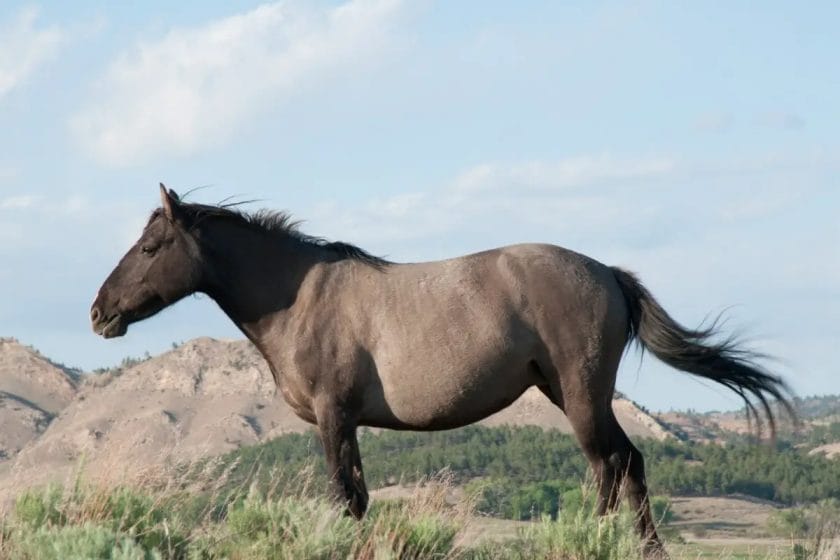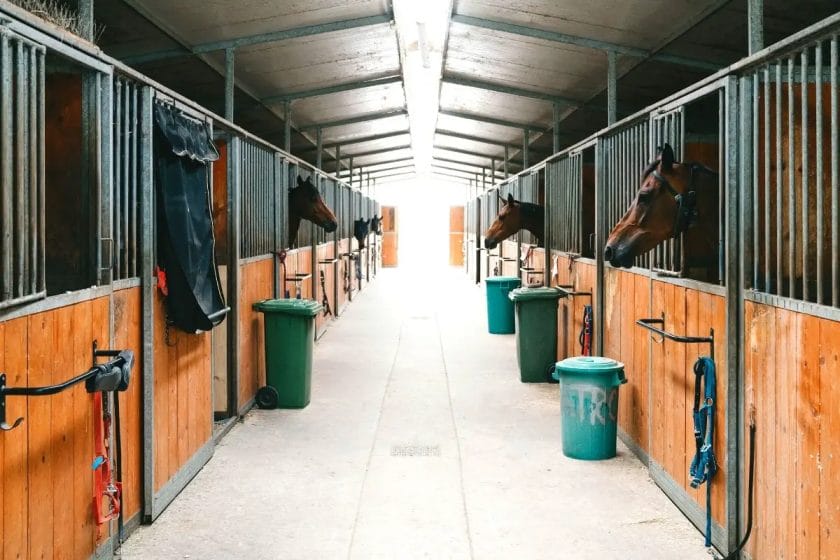A horse can stay in a stall for varying durations depending on its needs and the specific circumstances. It is generally recommended to give horses enough turnout time to exercise and socialize, as prolonged stall confinement can lead to health and behavioral issues. However, short periods of stall rest may be necessary for recovery from injury or during extreme weather conditions. Horse owners should prioritize the horse’s well-being and provide an appropriate balance between stall time and turnout.

Benefits of Regular Turnout: Why Horses Need Time Outside the Stall
Regular turnout, or allowing horses to spend time outside the stall in a paddock or pasture, is essential for their overall well-being and health. Horses are naturally grazing animals that thrive in an open and natural environment. Here are the key benefits of regular turnout:
1. Physical Health and Exercise
One of the primary reasons why horses need time outside the stall is to ensure they get enough exercise. In the wild, horses cover large distances while foraging for food. Regular turnout allows horses to move around, stretch their legs, and maintain a healthy weight. It helps prevent obesity, muscle stiffness, and joint problems that can arise from prolonged confinement.
2. Mental Stimulation and Natural Behavior
Horses are highly social and intelligent animals. When confined to a stall for long periods, they may experience boredom, stress, and frustration. Turnout provides an opportunity for horses to engage in natural behaviors such as grazing, interacting with other horses, and exploring their surroundings. This mental stimulation is vital for their overall well-being and helps prevent behavioral issues like cribbing and weaving.
3. Respiratory Health
Stalled horses are at a higher risk of developing respiratory issues due to the accumulation of dust, allergens, and poor air circulation. Regular turnout allows horses to breathe in fresh air and reduces the build-up of respiratory irritants. It promotes better lung function and helps prevent conditions like heaves and other respiratory diseases.
4. Hoof Health
When horses spend extended periods in a stall, their hooves can suffer. Limited movement and standing on bedding can lead to poor circulation and the development of hoof problems. Turnout on varied terrain helps promote healthy hoof growth, improves blood circulation in the hooves, and reduces the risk of hoof ailments like thrush and laminitis.
5. Social Interaction
Horses are herd animals and thrive on social interaction. In a stall, they are isolated from other horses, which can lead to feelings of loneliness and distress. Regular turnout in a group setting allows horses to establish and maintain social bonds. It reduces the risk of behavioral problems associated with social deprivation and improves their overall mental well-being.
6. Digestive Health
Being able to graze on grass or hay for extended periods is crucial for a horse’s digestive system. Regular turnout ensures that horses have access to the natural forage they need, which helps regulate their digestive function and prevents digestive disorders like colic. The act of grazing also stimulates saliva production, which aids in the breakdown and digestion of food.
7. Improved Overall Happiness
Ultimately, regular turnout contributes to a horse’s overall happiness and contentment. The freedom to move, interact with other horses, and engage in natural behaviors significantly enhances their quality of life. Horses that are regularly turned out tend to be more relaxed, exhibit fewer vices, and have a more positive outlook.
In summary, regular turnout is essential for maintaining the physical and mental well-being of horses. It provides them with the exercise, mental stimulation, social interaction, and access to natural grazing they need to thrive. Horse owners should prioritize regular turnout as part of their horse management practices to ensure the health and happiness of their equine companions.

Factors Affecting Stall Time: Exploring the Variables to Consider
When it comes to stall time, there are several factors that can influence how long an individual or organization stays in a stall. Understanding and analyzing these variables is crucial for effectively managing and mitigating stall situations. In this section, we will delve into the key factors that affect stall time and explore why they are important to consider.
1. Financial Stability
One of the primary factors that contribute to stall time is the financial stability of the entity in question. Organizations or individuals with strong financial reserves and low debt are better equipped to weather a stall and recover more quickly. On the other hand, those with limited financial resources may struggle to overcome the effects of a stall and experience prolonged recovery periods.
It is essential to assess the financial stability of an entity before anticipating and managing stall time. This involves conducting thorough financial analyses, evaluating cash flow patterns, and identifying potential risks or vulnerabilities that could prolong the stall period.
2. Market Conditions
The market conditions in which an entity operates can significantly impact the duration of a stall. Economic factors such as recessions, fluctuations in demand, and changes in consumer preferences can all contribute to longer or shorter stall times. Understanding the dynamics of the market and its potential impact on an organization’s operations is crucial for effective stall management.
Market research, trend analysis, and competitor monitoring are essential tools for assessing and predicting market conditions. By staying abreast of industry trends and anticipating potential market shifts, entities can proactively respond to stall situations and minimize their impact.
3. Leadership and Management
The leadership and management capabilities within an entity can also influence the duration of a stall. Strong and effective leadership can drive innovation, adaptability, and strategic decision-making, enabling an organization to navigate through a stall more efficiently. Conversely, ineffective leadership or management practices can prolong stall times and hinder recovery efforts.
Evaluating the leadership and management capabilities within an entity involves assessing the skills, experience, and decision-making processes of key individuals. Implementing robust leadership development programs and promoting a culture of continuous improvement can help enhance an organization’s ability to manage and reduce stall time.
4. Flexibility and Adaptability
The ability to be flexible and adapt to changing circumstances is another critical factor that affects stall time. Entities that can quickly adjust their strategies, operations, and resources in response to a stall have a higher likelihood of recovering more swiftly. On the other hand, organizations that are rigid and resistant to change may find it challenging to overcome a stall effectively.
Building a culture of flexibility and adaptability within an organization involves fostering a mindset that embraces change and encourages ongoing learning and innovation. By cultivating an agile and responsive environment, entities can enhance their ability to navigate through stall situations and minimize their impact.
5. External Support Network
The availability of an external support network can also play a significant role in reducing stall time. Organizations or individuals with access to mentors, industry experts, professional networks, and financial resources have additional avenues for seeking guidance and assistance during a stall. These external resources can provide valuable insights, advice, and support that can help expedite recovery efforts.
Building and nurturing an external support network involves actively seeking out connections within the industry, participating in professional associations, and establishing relationships with mentors or advisors. By leveraging these external resources, entities can tap into additional expertise and resources to overcome stall challenges more effectively.
Summary
Stall time can have severe repercussions for individuals and organizations alike. By understanding and analyzing the key factors that contribute to stall time, entities can develop proactive strategies to minimize its impact and expedite recovery. Financial stability, market conditions, leadership and management capabilities, flexibility and adaptability, and external support networks all play crucial roles in determining the duration of a stall. Taking these variables into consideration and implementing appropriate measures can help entities navigate through stall situations more effectively.

Managing Stall Time: Tips and Strategies for Keeping Horses Comfortable
Stall time is a necessary part of a horse’s daily routine, but it can also be a source of stress and discomfort if not managed properly. Horses are naturally active animals that thrive on movement and social interaction, so being confined to a stall for extended periods of time can lead to a variety of issues, including boredom, stiffness, and even behavioral problems. However, with the right strategies and attention to detail, you can help alleviate these problems and ensure that your horse stays comfortable and content during stall time.
1. Provide Adequate Space
One of the most important factors in keeping horses comfortable during stall time is to provide them with enough space. A standard 12’x12′ stall is the minimum requirement, but if possible, opt for a larger stall or provide additional turnout space to allow for more freedom of movement. This will help prevent stiffness and joint issues that can arise from prolonged confinement.
2. Use High-Quality Bedding
Choosing the right bedding is crucial for ensuring your horse’s comfort. Opt for high-quality bedding materials, such as straw or shavings, that provide adequate cushioning and absorbency. Keep the bedding clean and dry, as wet or soiled bedding can lead to skin irritations or respiratory issues for your horse.
3. Establish a Routine
Horses thrive on routine, so it’s important to establish a consistent schedule for stall time. Stick to a regular feeding schedule and provide plenty of fresh water at all times. Additionally, incorporate regular exercise and turnout periods into your horse’s routine to help break up the monotony of stall time.
4. Provide Environmental Enrichment
Boredom can be a significant issue for horses in stalls, so it’s essential to provide environmental enrichment to keep them mentally stimulated. This can be achieved through the use of toys, such as treat balls or hanging jolly balls, or by providing access to a window or viewing area where they can observe their surroundings.
5. Offer Frequent Social Interaction
Horses are social animals and thrive on interaction with both humans and other horses. Make an effort to spend quality time with your horse during stall time, whether it’s through grooming, hand-walking, or simply providing companionship. If possible, arrange for regular turnout or buddy turnout with compatible equine companions to fulfill their social needs.
6. Monitor Health and Wellness
Regular monitoring of your horse’s health and wellness is essential during stall time. Check for any signs of discomfort or stress, such as weight loss, changes in appetite, or abnormal behaviors. Schedule regular veterinary check-ups and dental exams to ensure your horse’s overall well-being.
7. Provide Mental Stimulation
Keeping horses mentally stimulated can help alleviate boredom and prevent behavioral problems. Provide opportunities for mental exercise, such as placing hay in various locations within the stall or using puzzle feeders to make mealtime more engaging. Incorporate clicker training or other forms of positive reinforcement training to provide mental challenges and promote learning.
8. Regular Turnout
If possible, provide regular turnout or access to a paddock or pasture. Allowing your horse to move freely and socialize with other horses can help alleviate the negative effects of extended stall time. However, ensure that the turnout area is safe and free from hazards to prevent injury.
9. Consider Adjustable Stall Features
Investing in adjustable stall features, such as a hay net or slow feeder, can help mimic natural grazing behavior and promote extended eating periods, which can help reduce boredom and prevent digestive issues.
10. Regular Grooming and Massage
Regular grooming and massage can help stimulate blood circulation and alleviate muscle stiffness that may arise from prolonged stall time. Use soft brushes or massage tools to provide gentle stimulation and relaxation for your horse.
Summary
Managing stall time is crucial for keeping horses comfortable and content. By providing adequate space, high-quality bedding, a consistent routine, environmental enrichment, social interaction, and monitoring health and wellness, you can help ensure that your horse stays happy and healthy during stall time. Regular turnout, mental stimulation, adjustable stall features, and grooming and massage further contribute to their overall well-being. Remember, a comfortable and content horse is a healthier and happier horse.
Potential Issues of Prolonged Stall Time: Recognizing the Risks and Solutions
When it comes to managing a business or project, time is of the essence. Prolonged stall time can have a detrimental impact on productivity and overall success. In this section, we will explore the potential issues that arise from prolonged stall time and discuss effective solutions to mitigate these risks.
1. Decreased Productivity
One of the most significant risks of prolonged stall time is decreased productivity. When a project or business process comes to a standstill, tasks and deadlines are not met, leading to delays and inefficiencies. This can result in missed opportunities, reduced revenue, and decreased customer satisfaction.
To address this issue, it is essential to identify the root cause of the stall and take proactive measures to resolve it. This may involve reallocating resources, reassigning tasks, or implementing new strategies to keep the momentum going.
2. Increased Costs
Prolonged stall time can also lead to increased costs. When projects are delayed or put on hold, expenses continue to accumulate without a corresponding increase in revenue. This can strain budgets and affect the financial stability of a business.
To mitigate the financial risks associated with prolonged stall time, it is crucial to closely monitor expenses and adjust budgets accordingly. Additionally, identifying cost-saving measures and finding alternative solutions can help minimize the impact of delays on the overall financial health of the business.
3. Loss of Competitive Advantage
In today’s fast-paced business environment, maintaining a competitive advantage is crucial for success. Prolonged stall time can result in lost opportunities and allow competitors to gain an edge in the market.
To prevent a loss of competitive advantage, businesses should prioritize agility and adaptability. Swiftly addressing and resolving stalled projects or processes can help maintain a competitive edge and ensure the business stays ahead of the competition.
4. Employee Frustration and Disengagement
Prolonged stall time can have a significant impact on employee morale and engagement. When employees are unable to progress or complete their work due to stalled projects, frustration and disengagement can set in.
To prevent employee frustration and disengagement, effective communication is key. Providing regular updates regarding the status of stalled projects, discussing potential solutions, and involving employees in problem-solving can help keep them motivated and engaged during challenging times.
5. Damage to Reputation
Repeated instances of prolonged stall time can tarnish a business’s reputation. Customers and stakeholders may perceive the organization as unreliable or inefficient, leading to a loss of trust and potential business opportunities.
To protect the reputation of the business, prompt action is vital. Communicating transparently about the reasons for the stall, implementing corrective measures, and consistently delivering on promises can help rebuild trust and restore the business’s reputation.
Summary
Prolonged stall time can pose various risks to a business or project, including decreased productivity, increased costs, loss of competitive advantage, employee frustration and disengagement, and damage to reputation. However, recognizing these risks and implementing effective solutions can help mitigate the negative impacts and ensure the successful execution of projects and smooth business operations. By prioritizing agility, effective communication, and proactive problem-solving, businesses can overcome the challenges associated with prolonged stall time and maintain their competitive edge.
FAQs
How long can a horse stay in a stall?
The amount of time a horse can stay in a stall depends on various factors such as the horse’s size, age, health, and exercise routine. Generally, horses should not be confined to a stall for more than 8-12 hours per day to ensure their physical and mental well-being. Regular turnout and exercise are important for their overall health.
Conclusion
In conclusion, the duration that a horse can stay in a stall varies depending on several factors. The horse’s physical and mental health, as well as its size and age, play a significant role in determining how long it can comfortably stay confined. While some horses may be able to tolerate being in a stall for longer periods, it is generally recommended to provide them with regular turnout and exercise. Prolonged confinement without proper exercise can lead to physical and behavioral issues for horses. Therefore, it is essential to prioritize their well-being by providing them with ample time outside the stall to move and socialize with other horses.
